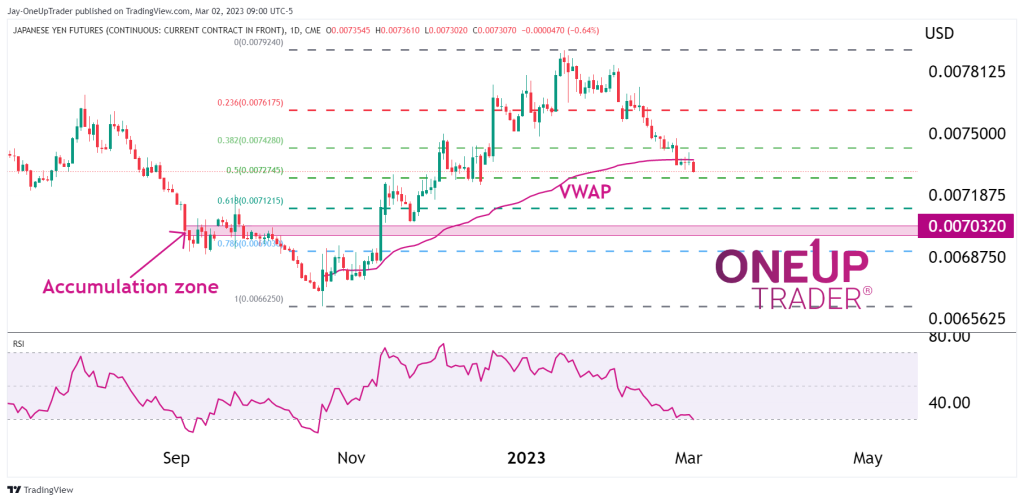- Analyzing the Yen’s continued slide against the dollar.
- Fib levels, VWAP, and RSI all point to a continuation in bearish price action.
- Inspirational story about a Yen trader.
The slide
The Yen has been sliding along with most other currencies against the dollar. 6J futures are down 7.5% since the start of the year.
The drop in the Yen is a trend follower’s dream, with retracements being shorted very quickly.
Fib Levels
Drawing a Fib retracement from last year’s low (0.0066) to the recent major swing high on the daily (0.0079) shows price is about to test the 50% retracement for that move.
If the Yen does break through that level, we could see the 0.786 level being the target for bears. There is a small accumulation zone going back to September of last year that may hold the price for a while. This price level is just above the 0.786 level, and bears will need to keep that in mind.
VWAP
Connecting the anchored vwap to the low of last year, price has just recently broken below it, giving the bears further conviction in their direction. This is bearish due to the fact that the price action has been smooth and trending.
RSI
The rsi has just approached oversold, but in a trending market like this, it is not a bullish sign. Bears can enjoy the confirmation that the rsi is trending with the overall market price and can assume price action to continue like this for some time.

Professional trader to hedge fund manager
In the early 2000s, there was a Japanese yen trader named Takeshi who worked for a major investment bank in Tokyo. Takeshi had been trading the yen for several years and had built up a reputation as one of the bank’s most successful traders.
One day, Takeshi received a tip from a friend in the industry that the Bank of Japan was planning to intervene in the currency markets to weaken the yen. Takeshi knew that if this were true, it would have a significant impact on the yen’s value and present a major trading opportunity.
Without hesitation, Takeshi began buying yen futures contracts, betting that the yen would rise in value if the Bank of Japan intervened. When the intervention was announced a few days later, the yen did indeed weaken, and Takeshi’s trades paid off handsomely.
Over the next few weeks, Takeshi continued to ride the yen’s upward momentum, making large profits for himself and his employer. However, his success did not go unnoticed by the bank’s rivals, who began to speculate that Takeshi had insider knowledge of the Bank of Japan’s plans.
A few months later, Takeshi was called into his boss’s office and questioned by the bank’s compliance department. Although he denied any wrongdoing, the bank decided to terminate his employment, citing concerns over his trading practices.
Despite this setback, Takeshi continued to trade the yen on his own and eventually set up his own hedge fund. Today, he is widely respected in the industry and is known for his astute analysis of the Japanese economy and financial markets.





